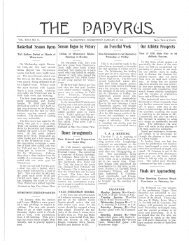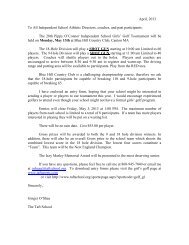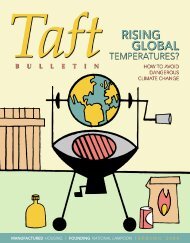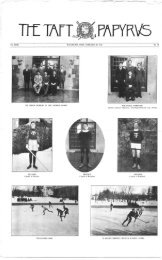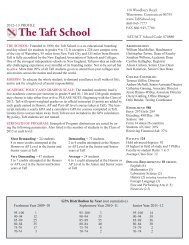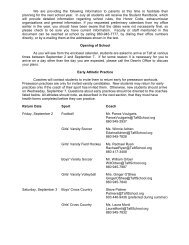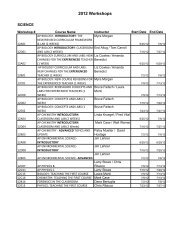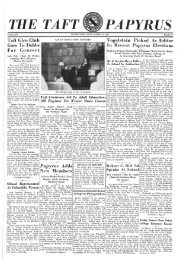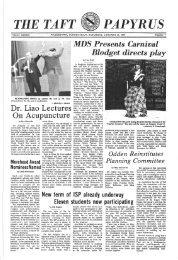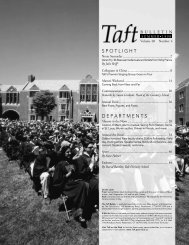S P O T L I G H T D E P A R T M E N T S - The Taft School
S P O T L I G H T D E P A R T M E N T S - The Taft School
S P O T L I G H T D E P A R T M E N T S - The Taft School
You also want an ePaper? Increase the reach of your titles
YUMPU automatically turns print PDFs into web optimized ePapers that Google loves.
E N D N O T E<br />
—By Dr. Alfred Gilman ’58<br />
This is truly an interesting experience for<br />
me. I speak formally to medical students,<br />
Ph.D. students, and scientific colleagues all<br />
the time, but I have never had the chance to<br />
speak formally to a group of young men and<br />
women in high school. I want you all to<br />
dream about being explorers. You must be<br />
an explorer in every aspect of your life, no<br />
matter what your pursuit.<br />
A goal as a scientist, teacher, or any<br />
other type of scholar should be to discover<br />
new truth and knowledge and/or better<br />
ways to impart that knowledge to the community.<br />
A goal as a physician should be to<br />
discover new ways to earn the trust that<br />
your patients have placed in you. A goal as<br />
an attorney should be to discover new and<br />
simple paths to fairness for all. A goal as a<br />
business person might be to discover new<br />
approaches to improve productivity and<br />
enhance satisfaction for your employees.<br />
When you look back, you will want to<br />
be able to say to yourself that you made a<br />
difference. You will want to be able to feel<br />
that you left the world a bit better for your<br />
presence. Otherwise, what was it all about?<br />
We are frighteningly insignificant in the<br />
grand scheme of things. We must not<br />
strive for less than making a difference.<br />
Here is a truism of life, but you will<br />
only believe it as you age: each fractional<br />
increment in life passes in equal apparent<br />
time. It is a geometric/ logarithmic system.<br />
For a 15-year-old to pass to age 20, you<br />
grow older by 33 percent in 5 years. To<br />
pass from 40 to 54 you age by 33 percent<br />
in 14 years. To pass from 60 to 80 you age<br />
by 33 percent in 20 years. But the bad news<br />
is that the 5 years starting at 15, the 14<br />
years starting at 40, and the 20 years starting<br />
at 60 seem to pass in equal time!<br />
A corollary of this truism is that most of<br />
you currently think you are immortal. You<br />
know that you are not, but you really believe<br />
that you are. You think you have all the time<br />
in the world, but you don’t. It is time to start<br />
the serious dreaming and planning.<br />
Now I want to spend a little bit of my<br />
time talking with you about science, particularly<br />
about biology and medicine. I was<br />
fortunate to start serious study of biology<br />
near the dawn of the age of enlightenment.<br />
1953 has been called “the end of history” in<br />
biology because it witnessed publication of<br />
the most important paper about biology to<br />
have ever been written.<br />
This paper is likely the most important<br />
ever published in all of science. And to go<br />
out on a limb, it is perhaps the most important<br />
paper that will ever be published in all<br />
of science, including the first descriptions of<br />
extra terrestrial life forms, which will happen<br />
some day. I hope that you know that<br />
the authors were James Watson and Francis<br />
Crick, and the discovery, published in a<br />
very brief two-page report, was of the<br />
double-helical structure of DNA.<br />
This fabulous structure showed two<br />
long strands of DNA wound helically around<br />
the same axis but running in opposite directions.<br />
<strong>The</strong> two strands were joined together<br />
because of beautifully complementary<br />
chemical bonding between pairs of the four<br />
bases that constitute the alphabet of DNA.<br />
An A on one strand dictated a T on the<br />
other, and vice versa, while a G on one<br />
strand dictated a C on the other, and vice<br />
versa. Thus, if the sequence of letters on one<br />
chain is given, the sequence on the other<br />
chain is determined automatically.<br />
When you look at some structures<br />
you don’t learn much about function. But<br />
when you look at this structure, you suddenly<br />
learn the secret of the most fundamental<br />
property of life—replication. In<br />
the most classic of all understatements,<br />
Watson and Crick wrote at the end of this<br />
brief report: “It has not escaped our notice<br />
that the specific pairing we have postulated<br />
immediately suggests a possible copying<br />
mechanism for the genetic material.”<br />
Where have we come since then? First,<br />
appreciation of the central dogma of biology:<br />
that DNA encodes the blueprint for life by<br />
specifying the sequences of RNA, and that<br />
the sequences of RNA specify the order of<br />
amino acids in proteins, which are the fundamental<br />
building blocks of cells. We have<br />
learned to read the blueprints of life and to<br />
clone and manipulate the genes in DNA.<br />
<strong>The</strong>se basic discoveries have had enormous<br />
practical consequences over the past<br />
20 years. To name just a few: <strong>The</strong> complete<br />
DNA sequence of most major pathogenic<br />
bacteria is now known, greatly facilitating<br />
design of new antibiotics, which we<br />
need very badly as bacteria become resistant<br />
to the older drugs. <strong>The</strong> complete<br />
DNA sequence of more complex eukaryotic<br />
organisms, such as yeast, worms, and<br />
fruit flies, is now known or will be soon.<br />
“…most of you currently think you are immortal. You know that<br />
you are not, but you really believe that you are. You think you<br />
have all the time in the world, but you don’t. It is time to start<br />
the serious dreaming and planning.”<br />
32 Winter 1999



